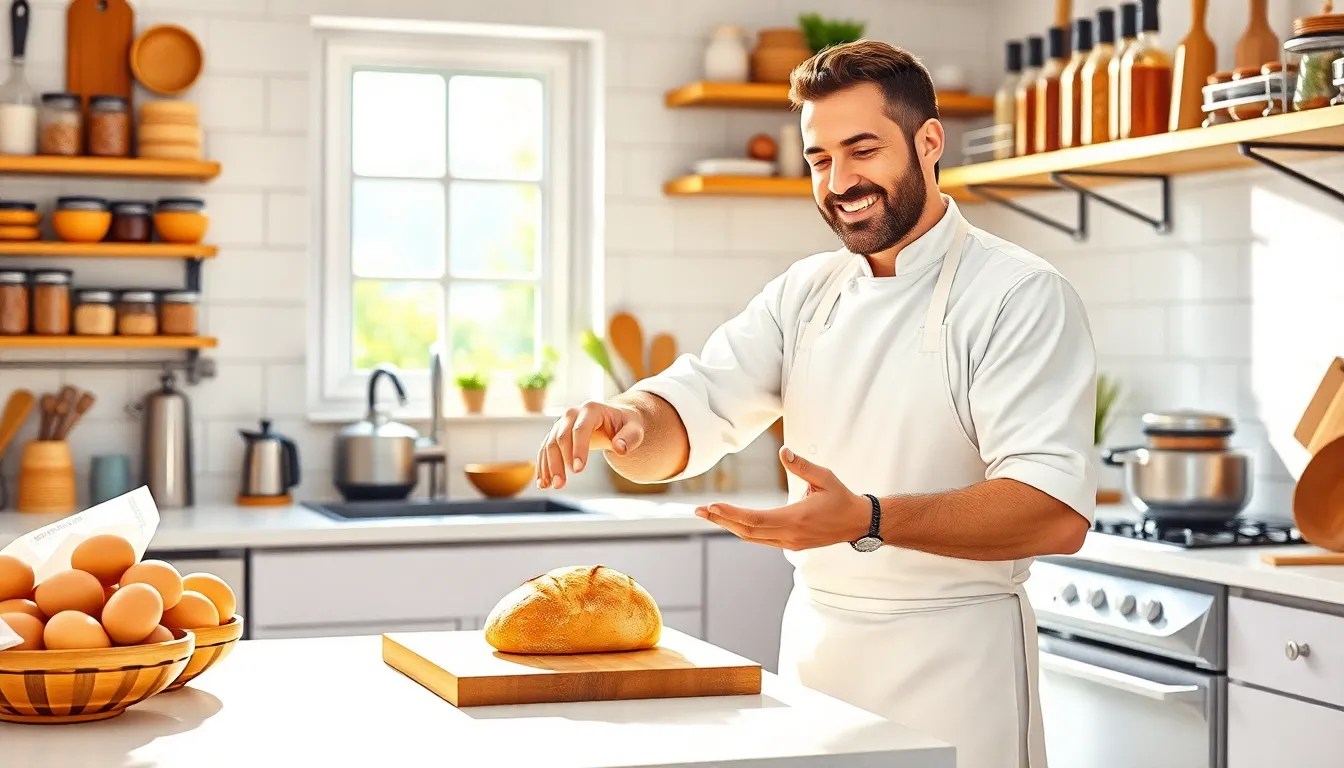Cooking is like a magical dance in the kitchen, where ingredients waltz together to create mouthwatering masterpieces. But with so many methods at their fingertips, home cooks often find themselves in a culinary conundrum. Should they sauté, steam, or maybe even try their hand at sous vide? It’s enough to make anyone question their life choices—or at least their dinner plans.
Table of Contents
ToggleMethods Of Cooking Food
Cooking food involves various techniques, each offering unique flavors and textures. Understanding these methods can enhance culinary skills and improve dish outcomes.
Baking
Baking applies dry heat in an oven, often for bread, cakes, or pastries. This method develops flavor through caramelization, while promoting an appealing texture. This technique suits both sweet and savory dishes.
Boiling
Boiling involves cooking food in rapidly bubbling water. Vegetables, pasta, and grains benefit from this method, which preserves nutrients when cooked briefly. Rapid boiling ensures a uniform cook throughout.
Sautéing
Sautéing requires quick cooking in a small amount of fat over high heat. This method works well for vegetables and meat, as it retains moisture while enhancing flavor. Stirring frequently prevents burning.
Steaming
Steaming cooks food using hot steam generated by boiling water. This method preserves color, texture, and nutrients. It proves beneficial for delicate items like fish and vegetables.
Roasting
Roasting uses dry heat to cook food evenly, typically in the oven. This method emphasizes caramelization, particularly suitable for vegetables and meats. The result showcases rich flavors and crispy exteriors.
Grilling
Grilling exposes food to direct heat from below, imparting a distinctive char. This method excels for meats and vegetables alike, providing a smoky flavor profile. High heat creates appealing grill marks and textures.
Poaching
Poaching cooks food gently in simmering liquid. This technique proves ideal for eggs, fish, or fruits, ensuring delicate flavors remain intact. Careful temperature control guarantees tender results without overcooking.
Frying
Frying subjects food to hot oil, creating a crispy exterior. This method divides into shallow and deep frying, making it suitable for a variety of items like meats and doughs. The result captures satisfying textures and rich flavors.
Understanding cooking methods enhances endeavors in creating meals. Each technique brings distinctive qualities, offering versatility in the kitchen.
Dry Heat Cooking

Dry heat cooking methods utilize direct heat to prepare food, often enhancing flavors and aromas. These techniques include baking and roasting, each offering distinct characteristics.
Baking
Baking employs dry heat surrounding food as it cooks, typically in an oven. This method often leads to the development of complex flavors through caramelization. Breads and pastries benefit from this technique, as moisture in the dough transforms into steam, resulting in a light, airy texture. Baking also allows for browning, creating appealing colors and textures. It’s common to use baking for cakes, cookies, and casseroles, providing versatile options for many meals.
Roasting
Roasting involves cooking food evenly in an oven, highlighting natural flavors and creating a desirable texture. Typically, this method is used for meats and vegetables, enhancing richness through caramelization. By exposing food to dry heat, it creates a crispy exterior while keeping the inside moist. Temperature and timing are crucial; higher heat can create a beautifully browned surface. Common roasted items include chickens, potatoes, and root vegetables that develop rich flavors and appetizing aromas.
Moist Heat Cooking
Moist heat cooking emphasizes methods that use water or steam to prepare food. These techniques enhance flavors, maintain moisture, and ensure a tender texture.
Boiling
Boiling involves cooking food in heated water at 212°F (100°C). This method quickly transfers heat to ingredients, making it ideal for pasta, vegetables, and eggs. The rapid bubbling causes the nutrients in vegetables to leach into the water, so using the cooking liquid in soups or sauces retains those nutrients. Common items such as potatoes and rice absorb moisture during boiling, becoming tender and flavorful. Precision in timing yields the best results, preventing overcooking and maintaining the food’s texture and color.
Steaming
Steaming cooks food by allowing steam to circulate around it. This method preserves nutrients, colors, and textures better than boiling. With water heated to 212°F (100°C), steam effectively cooks vegetables, fish, and dumplings without submerging them. Some benefits include retaining vitamins and minerals that boiling can diminish. Steam baskets or electric steamers help control temperature and timing, ensuring even cooking. Both broccoli and carrots remain bright and crunchy, showcasing vibrant colors and rich nutrients retained through this technique.
Combination Cooking
Combination cooking brings together both dry and moist heat methods, allowing for richer flavors and tender textures. This technique often involves an initial searing followed by slow cooking, ensuring the food remains juicy and flavorful.
Braising
Braising combines both dry and moist heat to tenderize tougher cuts of meat. Initially, the food gets browned in a skillet, developing a deep flavor through caramelization. Once seared, the food simmers in a flavorful liquid, usually broth or wine, covering it partially. Temperatures typically range from 300°F to 350°F (150°C to 175°C), allowing for low and slow cooking. Common options for braising include beef chuck or pork shoulder, resulting in juicy, tender meats that soak up the cooking liquid’s aroma and taste.
Stewing
Stewing involves cooking smaller pieces of food in liquid over low heat for an extended period. The process begins by browning the meat, similar to braising, enhancing the flavor profile. After browning, the food gets submerged in a mixture of broth, vegetables, and herbs, with temperatures typically around 200°F (93°C). This method is perfect for cuts like lamb or chicken thighs, as the long cooking time allows for rich flavor development while maintaining a moist texture. Ingredients meld together, creating a comforting and hearty dish that highlights the essence of combination cooking.
Cooking With Fat
Cooking with fat enhances flavors and adds richness to various dishes. Different methods of using fat lead to unique textures and outcomes.
Sautéing
Sautéing involves cooking food quickly in a small amount of fat over relatively high heat. This method promotes browning, intensifying flavors and retaining moisture in ingredients. Common fats used in sautéing include olive oil, butter, and canola oil. It’s effective for vegetables, meats, and seafood, allowing for quick preparation while preserving nutrients. The technique requires constant stirring to prevent sticking and burning, ensuring even cooking. Vegetables like bell peppers and mushrooms respond well to this method, developing rich flavors and vibrant colors.
Deep Frying
Deep frying immerses food in hot oil, creating crispy exteriors and tender interiors. Temperature control is crucial, as oil generally reaches about 350°F to 375°F (175°C to 190°C) during frying. Foods such as chicken and potatoes benefit from this method, achieving optimal crunch. The use of batter or breading adds additional texture and flavor, elevating the dish. Proper draining post-frying minimizes excess oil, enhancing the final presentation. Deep frying allows for a wide variety of culinary creations, from classic French fries to tempura vegetables.
Mastering various cooking methods opens up a world of culinary possibilities. Each technique brings its own unique flavors and textures to the table. Whether it’s the rich caramelization from roasting or the delicate touch of poaching, understanding these methods empowers home cooks to elevate their dishes.
Experimenting with different approaches not only enhances cooking skills but also fosters creativity in the kitchen. By embracing both dry and moist heat techniques, as well as the art of cooking with fat, anyone can transform simple ingredients into extraordinary meals. Ultimately, the joy of cooking lies in discovering what works best for individual tastes and preferences.




